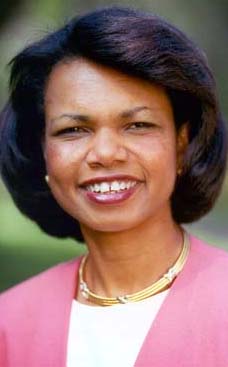February 15, 2006: Headlines: COS - Peru: African American Issues: Minority Volunteers: Music: Peace Corps: African-American Peace Corps volunteer Angela Jones has to her surprise blended into Peru
Peace Corps Online:
Directory:
Peru:
Peace Corps Peru:
The Peace Corps in Peru:
February 15, 2006: Headlines: COS - Peru: African American Issues: Minority Volunteers: Music: Peace Corps: African-American Peace Corps volunteer Angela Jones has to her surprise blended into Peru
African-American Peace Corps volunteer Angela Jones has to her surprise blended into Peru
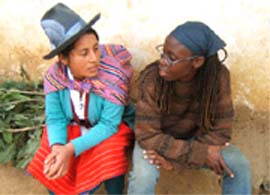
As one of her secondary projects, Jones recently formed an association of black volunteers along with two other Peace Corps colleagues. The association works as a support group and forum for understanding the experiences of Africans living in Peru. The group travels to villages with large black populations, where they talk with community members about their issues and integration into mainstream Peruvian society.
African-American Peace Corps volunteer Angela Jones has to her surprise blended into Peru
Peace Corps Volunteer Changing the Face of America Abroad
In celebration of the 45th anniversary and Black History Month, this is the second in a series of features on diverse Peace Corps volunteers.
WASHINGTON, D.C., February 15, 2006 African-American Peace Corps volunteer Angela Jones has to her surprise blended into Peru.
"I've sometimes been mistaken for a Peruvian from a part of the country where there is a healthy population of African Peruvians. It's a nice and unexpected feeling," Jones said, regarding her experience in diverse Peru, where ethnicities range from Amerindian to Black to Chinese.
A Detroit, Mich., native, Jones is a youth development volunteer in a small mountainous community. Throughout her time as a Peace Corps volunteer, she has used creative and unusual projects to be a powerful advocate for youth: organizing role playing workshops, poetry anthologies, and skits written and performed by her young students. She also works with children and adults teaching English.
As one of her secondary projects, Jones recently formed an association of black volunteers along with two other Peace Corps colleagues. The association works as a support group and forum for understanding the experiences of Africans living in Peru. The group travels to villages with large black populations, where they talk with community members about their issues and integration into mainstream Peruvian society. The group's travels have allowed them to develop a better understanding of the Peruvian culture, as well as allowed for Peruvians to get a better sense of the diverse makeup of the U.S.
"We formed this group for support, but also in an attempt to understand the experience of African Peruvians," said Jones. "As we visited villages with large black populations, we found that their experiences were similar to ours in America. And more important, we helped them learn that the U.S. is very diverse."
According to Jones, most Peruvians get their perception of American culture from American media such as television, movies, music and world news, which she thinks is not always a very good mirror of the country and its people. Jones constantly runs into Peruvians who are surprised when she tells them she's an American. Many people are taken aback, and some have even told her, "you must be a rarity as there are only 'white' people in the United States."
Although the cultural differences were difficult to get used to, she said her presence in local communities has altered perceptions of diversity in the United States.
Initially, before leaving the U.S. for the Peace Corps, Jones' family and friends were hesitant about her decision, but she said that being persistent in communicating a desire to serve made all the difference for her.
"Our families love us, and if we communicate well with them our desire to do good even if that's far from home then they have a tendency to understand, and even admire our decisions," said Jones.
Peru was one of the first countries to welcome Peace Corps volunteers, who began working there in 1962. Volunteers worked in grass-roots development projects targeting health, agriculture, education and business development, until the program was closed in 1975. Returning in 2002 after a 27-year hiatus, Peace Corps/Peru is responding to the national development needs of strengthening civil society, reducing poverty, and building human capital. The program reopened with two projects in the areas of small business development and health. A new youth development program began in March 2004.
African Influences in Peru: La Morena de Oro del Perú
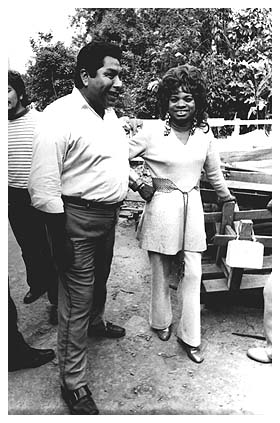
Lucha Reyes placed black performers among the leading interpreters of the vals criollo and marinera genres. Songs such as "Que Importa" of Juan Mosto (What Does One More Failure Matter)¸ with lyrics like "yet another failure is but a drop of water in the ocean for me" were made famous by Lucha Reyes and made here a National icon, as well as her songs, rich with Peruvian Nationalism and criollo pride.
Biography of Lucha Reyes
[Excerpt]
Lucila J. Sarsines Reyes (July 19, 1936-October 31, 1973), was a Peruvian performer and one the most respected singers of her country, one of Peru's most famous Afro-Peruvian personalities as well as a symbol of Peruvian nationalism both in Peru and to expatriates. Lucha Reyes placed black performers among the leading interpreters of the vals criollo and marinera genres. Songs such as "Que Importa" of Juan Mosto (What Does One More Failure Matter)¸ with lyrics like "yet another failure is but a drop of water in the ocean for me" were made famous by Lucha Reyes and made here a National icon, as well as her songs, rich with Peruvian Nationalism and criollo pride.
Followed by a public who idolized her in life, and wanting to close its existence with a finishing touch, Lucha Reyes asked composer Pedro Pacheco to write "Mi Ultima Cancion" ("My Last Song") one of her more touching and collected recordings, and on October 30, 1973, one day before her death, she sang "My Last Song" live in a well-known local radio broadcasting station with sincere tears in her eyes. On the following day, the October 31, 1973, Lucha Reyes, La Morena de Oro del Perú (the Gold Colored One of Peru) passed away. She is buried in the "Cemetery the Angel" in Lima.
Lucha Reyes - la Billie Holiday Peruana
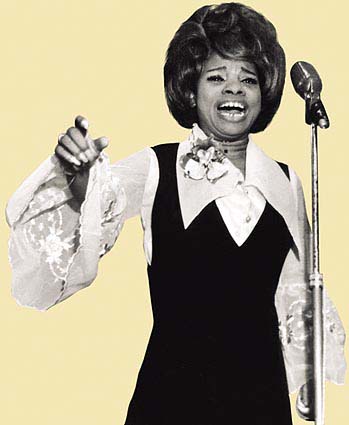
Se cumplen 30 años de la muerte de Lucha Reyes.
Lucha Reina
por Tulio Mora, Caretas
Y cómo pretender la voz más pura/ sin traicionar a mis estrellas/
sucias de moho y esputo./ Y cómo pretender el vals eterno/
sin dejar en las ventanas/ sangre niebla smog/ y no morir.
SU vida fue una telenovela, como deben ser las vidas de quienes están destinados a ser iconos del parnaso popular. El melodrama más triste del mundo que se puede sintetizar en un condicionamiento de ribetes trágicos griegos: "Tuvo cuatro handicaps terribles", afirma Eduardo Adrianzén, guionista de la serie "Regresa", inspirada en la vida de Lucha Reyes: "era mujer, pobre, negra y fea". Pero quizá estos obstáculos con sabor a condena a muerte o a anonimato, en la sociedad peruana, fueron los que contrastaron y resaltaron la única cualidad que se le debe pedir a una cantante: tener voz ("Tu voz/ tu voz/ tu voz/ tu voz existe/ anida en el jardín de lo soñado", cantaba en versos de Juan Gonzalo Rose). Y Lucha Reyes era la mejor.
Una simple biografía dirá que nació en el Rímac, en el barrio de Aromito, que tuvo 15 hermanos, que creció vendiendo loterías y mendigando y que casi muere carbonizada cuando se incendió su casa en los Barracones del Callao. Luego sería recogida por monjas franciscanas en el convento del Buen Retiro. Para el propio Adrianzén, "era la niña más pobre del mundo. Tan es así, que el primer valse que canta es "Abandonada", la historia de niña que mendiga por la ciudad y busca amor ("Vagaba sola por las calles, harapienta/ tenía el rostro demacrado por la crueldad").
Carente de toda técnica vocal, estudio musical o sofisticación artística, la voz de Lucha Reyes, prístina, se abrió paso en un mundo sin ecualizadores, en el que la música peruana se encontraba en apogeo o redescubrimiento gracias al velasquismo. Fue estrella en el circuito jaranero (que empezaba en el Karamanduka, pasaba por El Sentir de los Barrios, y cuyo trampolín era la Peña Ferrando -donde imitaba a Celia Cruz y a Lucha Reyes, una cantante mexicana homónima de comienzos de siglo), y luego alcanzó la fama grabando long plays que animarían hasta hoy los amores más desdichados de los bares de Barrios Altos y Cercado ("Aunque me odies", "Malabrigo", "Una carta al cielo"), y las polladas y anticuchadas de quienes aún se animan a reivindicar la limeñidad, si es que esto existe.
De "La Morena de Oro" no se sabe a ciencia cierta cuántos hijos tuvo ni cuántas parejas sentimentales, ni por qué no hizo nada por detener su muerte. Se sabe, sí, que se entregó a un destino que presentía (antes de fallecer mandó componer "Mi Última Canción" a Pedro Pacheco) dejando como testimonio de lucha su límpida voz de desgarro, que empató perfecto tanto con los criollos cholos-chinos-negros de la Lima proletaria de barriada, como con quienes redimían el valse peruano a través de Chabuca Granda (genio en las antípodas).
Cierto es también que "Regresa" es el non plus ultra de la lamentación nacional, y que figuras como la Reyes no volvieron a aparecer. Ella murió, como todo mito, joven (apenas 37 años), diabética, con una tuberculosis mal curada. Su fama apenas le duró 3 años, pero su leyenda obtuvo proporciones. La Edith Piaff peruana, para Michel Gómez, para otros la Billie Holiday, murió, como punto final de un guión imposible pero perfecto, en la víspera del Día de la Canción Criolla. Casi, como diciendo que nunca más se entendería una cosa sin la otra. (JP)
When this story was posted in February 2006, this was on the front page of PCOL:





Peace Corps Online The Independent News Forum serving Returned Peace Corps Volunteers
 | RPCV admits to abuse while in Peace Corps
Timothy Ronald Obert has pleaded guilty to sexually abusing a minor in Costa Rica while serving there as a Peace Corps volunteer. "The Peace Corps has a zero tolerance policy for misconduct that violates the law or standards of conduct established by the Peace Corps," said Peace Corps Director Gaddi H. Vasquez. Could inadequate screening have been partly to blame? Mr. Obert's resume, which he had submitted to the Peace Corps in support of his application to become a Peace Corps Volunteer, showed that he had repeatedly sought and obtained positions working with underprivileged children. Read what RPCVs have to say about this case. |
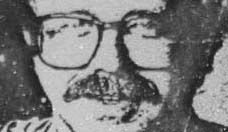 | Why blurring the lines puts PCVs in danger
When the National Call to Service legislation was amended to include Peace Corps in December of 2002, this country had not yet invaded Iraq and was not in prolonged military engagement in the Middle East, as it is now. Read the story of how one volunteer spent three years in captivity from 1976 to 1980 as the hostage of a insurrection group in Colombia in Joanne Marie Roll's op-ed on why this legislation may put soldier/PCVs in the same kind of danger. Latest: Read the ongoing dialog on the subject. |
 | PC establishes awards for top Volunteers
Gaddi H. Vasquez has established the Kennedy Service Awards to honor the hard work and service of two current Peace Corps Volunteers, two returned Peace Corps Volunteers, and two Peace Corps staff members. The award to currently serving volunteers will be based on a demonstration of impact, sustainability, creativity, and catalytic effect. Submit your nominations by December 9. |
 | Peace Corps at highest Census in 30 years
Congratulations to the Peace Corps for the highest number of volunteers in 30 years with 7,810 volunteers serving in 71 posts across the globe. Of course, the President's proposal to double the Peace Corps to 15,000 volunteers made in his State of the Union Address in 2002 is now a long forgotten dream. With deficits in federal spending stretching far off into the future, any substantive increase in the number of volunteers will have to wait for new approaches to funding and for a new administration. Choose your candidate and start working for him or her now. |
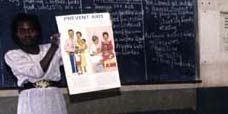 | The Peace Corps Library
Peace Corps Online is proud to announce that the Peace Corps Library is now available online. With over 30,000 index entries in 500 categories, this is the largest collection of Peace Corps related stories in the world. From Acting to Zucchini, you can find hundreds of stories about what RPCVs with your same interests or from your Country of Service are doing today. If you have a web site, support the "Peace Corps Library" and link to it today. |
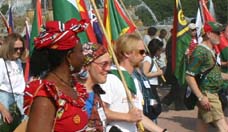 | Friends of the Peace Corps 170,000 strong
170,000 is a very special number for the RPCV community - it's the number of Volunteers who have served in the Peace Corps since 1961. It's also a number that is very special to us because March is the first month since our founding in January, 2001 that our readership has exceeded 170,000. And while we know that not everyone who comes to this site is an RPCV, they are all "Friends of the Peace Corps." Thanks everybody for making PCOL your source of news for the Returned Volunteer community. |
Read the stories and leave your comments.

Some postings on Peace Corps Online are provided to the individual members of this group without permission of the copyright owner for the non-profit purposes of criticism, comment, education, scholarship, and research under the "Fair Use" provisions of U.S. Government copyright laws and they may not be distributed further without permission of the copyright owner. Peace Corps Online does not vouch for the accuracy of the content of the postings, which is the sole responsibility of the copyright holder.
Story Source: Peace Corps
This story has been posted in the following forums: : Headlines; COS - Peru; African American Issues; Minority Volunteers; Music
PCOL25175
71








